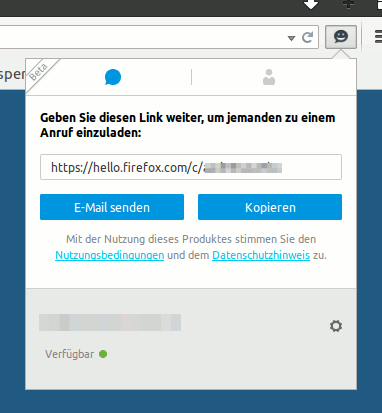Plasma Bigscreen ist eine Linux-Distribution vorrangig für den Raspberry Pi 4. Sie integriert Komponenten wie KDE Neon, Mycroft AI, KDE Plasma Bigscreen, libcec und (aktuell noch) Googles Speech-to-Text-Dienst (STT). Es ist aber geplant, für STT auf Mozillas DeepSpeech umzusteigen. In den Worten der Projektwebseite:
This project is using various open-source components like Plasma Bigscreen, Mycroft AI and libcec with a modified KDE Neon img for the Raspberry Pi 4 to allow easy accessing content-related services on your TV.
"Plasma Bigscreen im Beta-Test" vollständig lesen
 Seit Version 34 beinhaltet Mozilla Firefox den WebRTC-Client "Hello". Dadurch ist es beispielsweise möglich, Audio- und Video-Chats mit anderen Menschen durchzuführen, wenn deren Browser ebenfalls WebRTC unterstützt.
Seit Version 34 beinhaltet Mozilla Firefox den WebRTC-Client "Hello". Dadurch ist es beispielsweise möglich, Audio- und Video-Chats mit anderen Menschen durchzuführen, wenn deren Browser ebenfalls WebRTC unterstützt.
Ich habe vor kurzem (endlich einmal) "Hello" ausprobiert. Der Videochat hat auf Anhieb funktioniert, die Audio- und Video-Qualität war sehr gut, obwohl sich die Technologie noch im Beta-Stadium befindet. Aus diesem Grund ist allerdings der Client noch etwas rudimentär und bietet noch nicht alle Komfortfunktionen, die von anderen Instant Messengern bekannt sind. Immerhin lassen sich Kontakte bereits in einer Art Adressbuch verwalten, und der eigene Online-Status kann von "verfügbar" auf "bitte nicht stören" gestellt werden.
Vorteile von WebRTC
- WebRTC baut immer verschlüsselte Verbindungen auf, Video- und Audiostream werden verschlüsselt übertragen.
- Der Standard wird bereits von diversen Browsern und Plattformen unterstützt.
- Beim World Wide Web Consortium (W3C) befindet sich WebRTC gerade in der Standardisierungsphase als offener Standard.
- Die Technologie basiert auf HTML5 und JavaScript und kann daher relativ einfach in Web-Applikationen genutzt werden.
- Es wird keine Streamingserver benötigt, zwei Browser können direkt miteinander kommunizieren.
- Prinzipiell ist keine Registrierung bzw. kein Nutzerkonto nötig; es reicht, einen Link weiterzugeben.
Nachteile bitte in die Kommentare, wer hat schon Erfahrungen mit WebRTC gesammelt?
Je stabiler WebRTC wird, desto schneller dürfte sich ein Ökosystem an Diensten und Anwendungen rund um die Technologie entwickeln. Bereits heute gibt es einige Dienste, die auf WebRTC setzen. Ich bin sehr gespannt, was in 2015 und den folgenden Jahren noch alles kommt!
After playing around with Adobe's AIR during the last few weeks - and having installed a couple of neat applications running on AIR: Snitter, Tweetr, Analytics Reporting Suite - I today came upon an interesting project by the clever people at the Mozilla Labs. It had been known as Webrunner, but they call it Prism now. In short, Prism provides a complete XUL based GUI that uses Gecko for running pseuo-standalone web applications. Imagine a single Firefox window minus all controls and menus that display only one web site per window. Sounds like a step back into long forgotten times of tab-less browsers? It somehow feels like it - and then again, it doesn't.
 Prism allows you to save shortcuts to web sites (mail.google.com, for example) to a shortcut on your desktop. You can then open a Google Mail browser window that in a way looks like a single application. It's not, of course, but the developers want to make it possible to create those application links from within Firefox. The more I think about Prism, the more I classify it as an alternative way to store your bookmarks, nothing more. Yet, it feels different and could eventually bring forth a handling similar to AIR applications. You probably figured out that I'm still undecided on how to judge Prism. I like what can be achieved by AIR, but what extra value does Prism give us?
Prism allows you to save shortcuts to web sites (mail.google.com, for example) to a shortcut on your desktop. You can then open a Google Mail browser window that in a way looks like a single application. It's not, of course, but the developers want to make it possible to create those application links from within Firefox. The more I think about Prism, the more I classify it as an alternative way to store your bookmarks, nothing more. Yet, it feels different and could eventually bring forth a handling similar to AIR applications. You probably figured out that I'm still undecided on how to judge Prism. I like what can be achieved by AIR, but what extra value does Prism give us?
In other news, version 0.7 of both Sunbird and Lightning was released yesterday, and my first impression is that it's quite stable. I installed the Provider for Google Calendar 0.3 and now am happily reading from and writing to GCal. As with Google Mail, I like their web interface, but a desktop app has its advantages. Not that I mention it: Everybody's talking about moving from desktop to the web. But AIR, Prism, and a couple of other architectures bring the web to the desktop. Now how does that fit in?
 Seit
Seit 